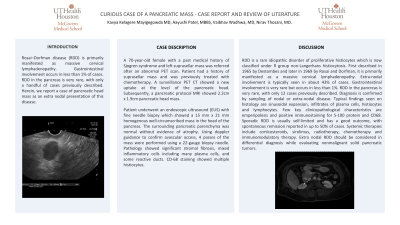Tuesday Poster Session
Category: Biliary/Pancreas
P2930 - Curious Case of a Pancreatic Mass - Case Report and Review of Literature
Tuesday, October 24, 2023
10:30 AM - 4:00 PM PT
Location: Exhibit Hall

Has Audio
- KK
Kavya Kelagere Mayigegowda, MD
University of Texas Health Science Center at Houston
Houston, TX
Presenting Author(s)
Kavya Kelagere Mayigegowda, MD1, Aayushi Patel, MBBS2, Vaibhav Wadhwa, MD1, Nirav Thosani, MD3
1University of Texas Health Science Center at Houston, Houston, TX; 2UT Health, Houston, TX; 3McGovern Medical School at UTHealth, Houston, TX
Introduction: Rosai–Dorfman disease (RDD) is primarily manifested as massive cervical lymphadenopathy. Gastrointestinal involvement occurs in less than 1% of cases. RDD in the pancreas is very rare, with only a handful of cases previously described. Herein, we report a case of pancreatic head mass as an extra nodal presentation of this disease.
Case Description/Methods: A 70-year-old female with a past medical history of Sjogren syndrome and left suprasellar mass was referred after an abnormal PET scan. Patient had a history of suprasellar mass and was previously treated with chemotherapy. A surveillance PET CT showed a new uptake at the level of the pancreatic head. Subsequently, a pancreatic protocol MRI showed 2.2cm x 1.9cm pancreatic head mass. Patient underwent an endoscopic ultrasound (EUS) with fine needle biopsy which showed a 15 mm x 21 mm homogenous well-circumscribed mass in the head of the pancreas. The surrounding pancreatic parenchyma was normal without evidence of atrophy. Using doppler guidance to confirm avascular access, 4 passes of the mass were performed using a 22-gauge biopsy needle. Pathology showed significant stromal fibrosis, mixed inflammatory cells including many plasma cells, and some reactive ducts. CD-68 staining showed multiple histiocytes.
Discussion: RDD is a rare idiopathic disorder of proliferative histiocytes which is now classified under R group non-Langerhans histiocytosis. First described in 1965 by Destombes and later in 1969 by Rosai and Dorfman, it is primarily manifested as a massive cervical lymphadenopathy. Extra-nodal involvement is typically seen in about 43% of cases. Gastrointestinal involvement is very rare but occurs in less than 1%. RDD in the pancreas is very rare, with only 12 cases previously described. Diagnosis is confirmed by sampling of nodal or extra-nodal disease. Typical findings seen on histology are sinusoidal expansion, infiltrates of plasma cells, histiocytes and lymphocytes. Few key clinicopathological characteristics are emperipolesis and positive immunostaining for S-100 protein and CD68. Sporadic RDD is usually self-limited and has a good outcome, with spontaneous remission reported in up to 50% of cases. Systemic therapies include corticosteroids, sirolimus, radiotherapy, chemotherapy and immunomodulatory therapy. Extra nodal RDD should be considered in differential diagnosis while evaluating nonmalignant solid pancreatic tumors.
Disclosures:
Kavya Kelagere Mayigegowda, MD1, Aayushi Patel, MBBS2, Vaibhav Wadhwa, MD1, Nirav Thosani, MD3. P2930 - Curious Case of a Pancreatic Mass - Case Report and Review of Literature, ACG 2023 Annual Scientific Meeting Abstracts. Vancouver, BC, Canada: American College of Gastroenterology.
1University of Texas Health Science Center at Houston, Houston, TX; 2UT Health, Houston, TX; 3McGovern Medical School at UTHealth, Houston, TX
Introduction: Rosai–Dorfman disease (RDD) is primarily manifested as massive cervical lymphadenopathy. Gastrointestinal involvement occurs in less than 1% of cases. RDD in the pancreas is very rare, with only a handful of cases previously described. Herein, we report a case of pancreatic head mass as an extra nodal presentation of this disease.
Case Description/Methods: A 70-year-old female with a past medical history of Sjogren syndrome and left suprasellar mass was referred after an abnormal PET scan. Patient had a history of suprasellar mass and was previously treated with chemotherapy. A surveillance PET CT showed a new uptake at the level of the pancreatic head. Subsequently, a pancreatic protocol MRI showed 2.2cm x 1.9cm pancreatic head mass. Patient underwent an endoscopic ultrasound (EUS) with fine needle biopsy which showed a 15 mm x 21 mm homogenous well-circumscribed mass in the head of the pancreas. The surrounding pancreatic parenchyma was normal without evidence of atrophy. Using doppler guidance to confirm avascular access, 4 passes of the mass were performed using a 22-gauge biopsy needle. Pathology showed significant stromal fibrosis, mixed inflammatory cells including many plasma cells, and some reactive ducts. CD-68 staining showed multiple histiocytes.
Discussion: RDD is a rare idiopathic disorder of proliferative histiocytes which is now classified under R group non-Langerhans histiocytosis. First described in 1965 by Destombes and later in 1969 by Rosai and Dorfman, it is primarily manifested as a massive cervical lymphadenopathy. Extra-nodal involvement is typically seen in about 43% of cases. Gastrointestinal involvement is very rare but occurs in less than 1%. RDD in the pancreas is very rare, with only 12 cases previously described. Diagnosis is confirmed by sampling of nodal or extra-nodal disease. Typical findings seen on histology are sinusoidal expansion, infiltrates of plasma cells, histiocytes and lymphocytes. Few key clinicopathological characteristics are emperipolesis and positive immunostaining for S-100 protein and CD68. Sporadic RDD is usually self-limited and has a good outcome, with spontaneous remission reported in up to 50% of cases. Systemic therapies include corticosteroids, sirolimus, radiotherapy, chemotherapy and immunomodulatory therapy. Extra nodal RDD should be considered in differential diagnosis while evaluating nonmalignant solid pancreatic tumors.
Disclosures:
Kavya Kelagere Mayigegowda indicated no relevant financial relationships.
Aayushi Patel indicated no relevant financial relationships.
Vaibhav Wadhwa indicated no relevant financial relationships.
Nirav Thosani: Abbvie – Consultant. Boston Scientific Corp – Consultant. Pentax America – Consultant. ROSEAID inc – Creatorship rights.
Kavya Kelagere Mayigegowda, MD1, Aayushi Patel, MBBS2, Vaibhav Wadhwa, MD1, Nirav Thosani, MD3. P2930 - Curious Case of a Pancreatic Mass - Case Report and Review of Literature, ACG 2023 Annual Scientific Meeting Abstracts. Vancouver, BC, Canada: American College of Gastroenterology.
